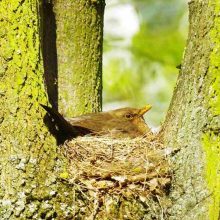Does success early in life affect senescence of Common Blackbird females?
LINKED PAPER
Age-specific reproduction and disposable soma in an urban population of Common Blackbirds Turdus merula. Jankowiak Ł., Zyskowski D., Wysocki D. 2017. IBIS. DOI: 10.1111/ibi.12512. VIEW
Most big cities in Poland have a city park. In Żeromski Park in Szczecin, north-eastern Poland, if you are lucky you can spot a person running around through the bushes and trees with long nets. They do this every day in spring, trying to catch birds. Please take a moment to imagine the facial expressions of passing walkers and cyclists – most of them are probably thinking “what are these people doing, and why don’t they find a normal, proper, job?” None of these passers-by are aware what these strange people actually do, and that through regular catching, ringing and observation of Blackbirds, they not only know the exact age of almost all the birds in their park, but they know also who mates with whom. These researchers are in the park almost every day in spring and once a week during the rest of the year, so they feel as much at home in their park as the birds do.

The above description gives an idea of a typical fieldwork day in Żeromski Park, where the population of the urban Blackbird, Turdus merula, is studied since 1997. Thanks to many years of data collection through observations and catching of birds, we were able to collect data on the lifetime breeding success of our ringed Blackbirds. Knowing the age of a bird and their breeding performance allows to us test how aging and then senescence may affect breeding performance. We were especially interested in finding out whether high breeding performance early in life has an influence later in life through diminished breeding success. The most plausible explanation for this kind of impact of senescence is that of energy allocation and the disposable soma theory. The body suffers “wear and tear” over time and, according to the disposable soma theory, if more energy is invested in breeding, there is less energy left available to invest in body repair.

We found that individual breeding success increased with age for females, up to the age of four, but for males breeding success was stable up to age five. We also found that high breeding effort during the early life of females affected their probability of breeding success later in life. What was really interesting was that early-life breeding effort did not affect survival later.
The age-related changes observed in the first year of life can be generally associated with individual improvement with age of females. Individuals can increase their breeding ability by improving their foraging skills, by forming long-lasting pair bonds, through earlier initiation of reproduction, holding larger breeding territories and improved nest-building efficiency. But at the same time, we found that individuals with poor success disappeared from our study population, and simply ‘good-quality’ individuals were better able to survive than ‘poor-quality’ individuals.
However, after the peak years of breeding success, old age is inevitable. Until recently, it was thought that natural aging in wild population occurs very rarely, but now many studies, including our own, show that senescence is a widespread phenomenon in wild populations. Our data allowed us to test whether early life fecundity influences later performance and we found that it was true only for females. The best strategy for females was to invest at early life. Females that did this had the highest life-time success, but they paid for it through a rapid decline of reproductive performance. These results are consistent with the disposable soma hypothesis.
As is usually the case with research, our study has created more questions than it answers. The next question we would like to tackle is: what are the mechanisms that result in the biggest gene transfer into the next generations? So nothing will change in the Żeromski Park in Szczecin. The strange people running around with nets chasing birds will continue to amuse and bewilder the park visitors.
References and further reading
Bouwhuis, S., Vedder, O. 2017. Chapter 8: Avian escape artists? Patterns, processes and costs of senescence in wild birds. In Shefferson, R.P., Jones, O.R. & Salguero-Gómez, R. (eds.). The Evolution of Senescence in the Tree of Life: 156–174. Cambridge: Cambridge University Press. VIEW
Desrochers, A. 1992a. Age-related differences in reproduction by European Blackbirds: restraint or constraint? Ecology 73: 1128–1131. VIEW
Desrochers, A. 1992b. Age and foraging success in European blackbirds: Variation between and within individuals. Animal Behaviour 43: 885–894. VIEW
Desrochers, A. & Magrath, R.D. 1993. Age-specific fecundity in European blackbirds (Turdus merula): individual and population trends. Auk 110: 255–263. VIEW
Jankowiak, Ł. &, Wysocki, D. 2016. Do individual breeding experience and parental effort affect breeding season length in blackbirds? Behavioral Ecology 27: 829-834. VIEW
Kirkwood, T.B. & Rose, M. 1991. Evolution of senescence: late survival sacrificed for reproduction. Philosophical transactions of the Royal Society of London. Series B, Biological sciences 332: 15–24. VIEW
Wysocki, D., Jankowiak, Ł., Greño, J.L., Cichocka, A., Sondej I. & Michalska, B. 2015. Factors affecting nest size in a population of Blackbirds Turdus merula. Bird Study 62: 208–216. VIEW
Image credit
Featured image: Female Common Blackbird Turdus merula on the nest © T.Rek
If you want to write about your research in #theBOUblog, then please see here.





